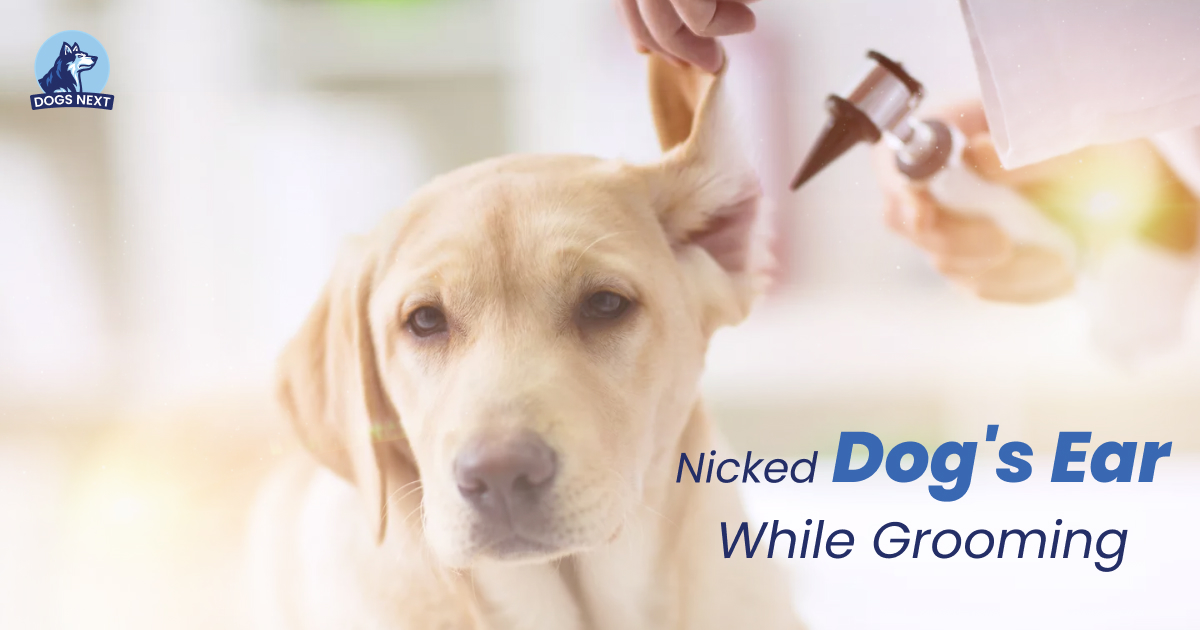Do you accidentally nick a dog’s ear while grooming? Don’t panic! Accidents can happen even when we take the utmost care, and unfortunately, it’s not uncommon for pets to get nicked or cut during grooming. If your dog’s ear has been nicked while grooming, it’s important to remain calm and assess the situation.
Apply gentle pressure to the affected area to stop any bleeding, and clean the wound with an antiseptic. If the cut is deep or if it doesn’t stop bleeding, seek veterinary attention immediately. In the future, take extra precautions when grooming your pet to minimize the risk of injury.
Remember, a calm and reassuring presence can help your dog feel at ease during grooming and aid in preventing accidents.
Table of Contents
Accidentally nicked a dog’s ear while grooming? Here’s What to Do
Even when we take the utmost care when grooming our pets, accidents can occur. There is a common mishap that occurs when grooming a dog and you accidentally nick their ear. As frightening as this experience can be, it is important that both the owner and the pet remain calm, allowing us to step in and handle the situation appropriately.
How to deal with nicking your dog’s ear when grooming him is the subject of this article. The wound will be cleaned and cared for, when veterinary attention is necessary, and how to prevent future accidents. Healing your furry friend and getting them back to health and happiness can be done with the right approach.
Keep Your Dog Steady
In any situation, especially an emergency one, you are likely to know how to secure and hold your dog since you are the one who knows them best. The following tips may be helpful:
- A Tiny Furball’s Guide If your dog is small, place him on a table or counter. By doing so, you can get a better handle on them since they have little room to move around.
- Dedicated to the Big Buddies Getting down on the ground is the best way to interact with large dogs. Making eye contact and being face-to-face with them may calm them. In addition, it gives you the ability to act as an anchor as your dog is forced to endure an unruly sea of pain.
- Get in touch with a friend If you need someone to hold your buddy while you carry out the necessary trauma procedures, get your partner, family member, or friend (someone the dog already trusts). You must make the most of a bad situation by familiarising your dog with the person who holds them.
- Put the muzzle on. A muzzle can be used to secure the jaw of your dog if it is prone to biting when nervous or hurt. A vet can recommend what’s best for situations like this, and you can buy them in any pet store or online. Leather belts may also be useful in a pinch.
- Put your best foot forward. Take whatever steps are necessary to make things work. It’s your dog that knows your pet best, as I’ve said before. There is a good chance that you will be able to keep them stable.
Damage Analysis
It’s normal for cuts to bleed a great deal while others bleed very little. This means that you may have different treatment options depending on the type of cancer you have.
Scratch only
You do not need to see your veterinarian if you treat small gashes and cuts appropriately, but you should consult your vet nonetheless. If you see blood on a dog’s ear wound, it is important to take note of how much is present. These steps can be followed if the bleeding is not severe.
Your dog’s ear doesn’t bleed too much if the cut is small:
- Warm water will help heal the cut.
- If you’re using a towel, make sure it’s clean (paper or cloth).
- Apply an antiseptic solution like Chlorhexidine to the wound again.
- The wound should be treated with an antibacterial ointment containing three antibiotics (avoid products that contain corticosteroids, such as hydrocortisone).
- It is recommended that you do not allow your dog to disturb the area for at least 10 minutes. If they lick or rub the affected area, a light, loose bandage may be appropriate.
- If the skin does not heal within two or three days of the first application, repeat steps 1 through 5.
The flow of blood
Definitely go to the vet if you have large/deep cuts that bleed a lot. You’ll have to consult your dog’s vet or any available vet if the flow of blood won’t slow after applying direct pressure for several minutes. The bleeding has to be stopped before you rush your buddy anywhere.
The Key to Effective Treatment
An Elizabethan collar also called an E-collar or pet cone, is recommended if your dog has a wound or is prone to ear infections. Dogs aren’t allowed to scratch, lick, or rub the area with this cone-shaped device. Veterinary doctors might need to wrap a flex bandage around a dog’s floppy ear if it’s over its head.
A proper healing process can be ensured with an E-collar. For your pet’s health and well-being, this may be uncomfortable, but it is a necessary precaution.
How to Care for a Dog’s Torn Ear
From pushing their way through thorn bushes to getting into fights, dogs can damage their ear flaps, called pinnas. It is common for dogs to have veins that run along the edge of their ear flaps. An injury to this marginal ear vein can result in heavy bleeding, so it is crucial to respond quickly in such circumstances.
To control bleeding, you must apply a headband to your dog’s torn ear before taking him to the veterinarian. With some household items or a first-aid kit, you can make a head bandage.
1. Using a First Aid Kit to make a bandage
- Get the wound cleaned and disinfected.
- Use a clean towel
- Gauze it on
- Make sure the wound is bandaged.
- Make sure it’s secure.
- Go to the vet for your dog.
2. How to make an improvised headband
- Bandage it up.
- Use styptic powder
- Sanitary pads are great.
- Cut the dry paper towel into strips.
- Create a headband with the right goals in mind.
3. Vets can check your ears
- Visit the vet with your dog.
- Check out the bleeding with your vet.
- Decide if you need sutures for the ear.
4. Taking care of your ear
- When it’s time to take it off, remove it.
- Disinfect water with salt.
- Take the bandage off your dog.
- Whenever you need to, rinse the wound.
- Dress your wounds fresh.
How to Control Ear Bleeding in Dogs
Anyone who’s ever tried to stop a dog’s ear from bleeding knows how hard it can be. He’ll shake his head and start bleeding again even after you use pressure and towels to slow down the bleeding. It is possible to use clotting aids, such as flour or baby powder, in order to stop blood flow and prevent the wound from reopening with a little bit of research.
1. The best way to stop the bleeding in a dog’s ear
- Do not lose your cool.
- Put your dog in a quiet place.
- The injured area should be pressured.
- A clotting aid, cornstarch, or flour
- The area needs to be cleaned up.
- Veterinary care should be sought.
2. Keeping the wound from reopening
- Take a quiet walk with the dog and observe him.
- Don’t let the dog shake or scratch its ears
- Two or three days with an Elizabethan collar
- Make sure dog ears are clean
- Make a headband
Common injuries while grooming dogs
Your dog’s health and appearance depend on how well they are groomed. It is however important to understand that accidents can occur during the grooming process, even with the best intentions, which can result in injuries to the groomer. As a result of dog grooming, there are some common injuries may occur:
- Cuts and nicks – Accidental cuts can occur while trimming nails or hair, and can range from minor scratches to deep lacerations.
- Burns – Hot grooming tools such as clippers or hair dryers can cause burns if not used carefully.
- Eye injuries – Debris or shampoo can accidentally get into your dog’s eyes, causing irritation or infection.
- Ear injuries – Over-cleaning or improper handling of the ears can lead to irritation, scratches, or even ruptured blood vessels.
- Nail injuries – Nail injuries can occur when a dog’s nails are overcut, causing bleeding and pain. To avoid this, use nail trimmers and ensure safety by not using any sharp equipment without caution.
There are a number of grooming techniques that can prevent these injuries from occurring and keeping calm and patient during this process can help you avoid these injuries from occurring.
If your dog suffers an injury, it is extremely important to get it treated by a veterinarian as soon as possible. If you take the proper precautions and care, you can ensure your furry friend’s safety and happiness while grooming.
Dogs with other types of ear injuries
In addition to grooming, there are other factors that can cause ear injuries in dogs in addition to factors related to grooming. Furthermore, ear injuries can also happen to dogs who are not affected by these types of ear injuries as well, such as:
- An ear infection or excessive shaking can cause hematomas, which are collections of blood inside the ear flap.
- It is common for dogs to get small objects lodged in their ears such as grass awns or ticks, which would cause discomfort to the dog.
- As a result of trauma, injuries such as fractures, dislocations, or cuts in the ear can occur as a result of blunt force trauma or accidents.
- An ear infection can lead to inflammation, redness, and discharge in dogs with allergies, resulting in painful inflammation, redness, and discharge in their ears.
- The less commonly seen condition is a dog developing a tumor in his or her ear, which can result in bleeding, discharge, or a lump that is visible to the human eye.
Veterinary care should be sought if you notice your dog shaking his head, scratching his ears, or having discharge or redness. A painful ear injury can get worse if you don’t treat it. Your furry friend can get ear injuries if he/she gets proper care and attention.
Dog Grooming Injuries and How to Care for Them
| Type of Injury | How to Care | How to Avoid Injury |
| Cuts and Lacerations | Clean the wound with lukewarm water and apply pressure to stop the bleeding. If the cut is deep, seek veterinary care for stitches. | Use proper grooming tools and techniques. Keep your dog calm during grooming. |
| Burns | Flush the burn with cool water for at least five minutes. Apply a cool compress to the affected area and seek veterinary care if necessary. | Avoid using hot water or heat-generating tools during grooming. Be cautious when using chemical products. |
| Eye Injuries | Use caution when cleaning ears or trimming the fur around the ears. | Trim nails carefully and avoid cutting the quickly. Use proper nail clippers. |
| Ear Injuries | If your dog’s ear is injured, gently clean the area with a mild, non-irritating solution. Apply pressure to stop any bleeding. Seek veterinary care if necessary. | Use caution when trimming the fur around the eyes. Keep sharp objects away from the face. |
| Nail Injuries | If the nail is broken or bleeding, wrap the paw with a clean cloth and apply pressure to stop the bleeding. If the bleeding doesn’t stop, seek veterinary care. | Trim nails carefully and avoid cutting the quick. Use proper nail clippers. |
| Skin Irritations and Allergic Reactions | Bathe your dog with mild shampoo and rinse thoroughly. Apply a topical treatment or cream as recommended by your veterinarian. | Use grooming products designed for dogs. Be aware of any allergies or sensitivities your dog may have. |
Frequently Asked Questions
Q: Grooming your dog and cutting its ear?
Ans: Apply a compress to a small cut in order to stop the bleeding. Wash the area with saline to stop the bleeding. Applied antibiotic ointment to the wound once the bleeding has stopped. It’s important to notify the owner of an injured dog immediately upon collection if they’re in your care
Q: Can a dog’s ear be swollen after it has been cut?
Ans: There may be minor wounds on dogs’ ears that appear to be minor, but the wounds can typically take 1-2 weeks to treat and heal.
Q: How do I treat an ear cut on my dog?
Ans: Having had a dog with an ear infection can be a frightening experience for an owner, but as long as the ear is cleaned regularly, the dog will remain happy and healthy. It is highly recommended that you visit your doctor if you have sustained a larger cut in the ear. As dog’s age, their skin becomes thinner and thinner.
Q: Do dogs’ ears stop bleeding after a cut?
Ans: Furthermore, ear injuries tend to bleed for a very long period of time before they cease to bleed. A dog with a laceration usually requires sedation, cauterization of any vessels, and stitches.
Conclusions
Accidents happen, and unfortunately, one of the risks of grooming your dog is the potential for injury. If you have accidentally nicked a dog’s ear while grooming, it’s important to remain calm and take action promptly to address the injury. Seek veterinary care if necessary, and make sure to follow any instructions for wound care or use of an Elizabethan collar or other protective device to prevent further injury.
With proper precautions and care, you can help prevent injuries during grooming and ensure a safe and happy experience for both you and your furry friend. Remember to always prioritize your dog’s health and well-being, and seek professional help when needed.

I’m David, an expert contributor and writer, with two furry friends of my own, I know the challenges of raising and caring for dogs. From training to nutrition and health, my goal is to provide valuable insights and advice to help create strong bonds and happy, healthy lives. Find me in Twitter.




